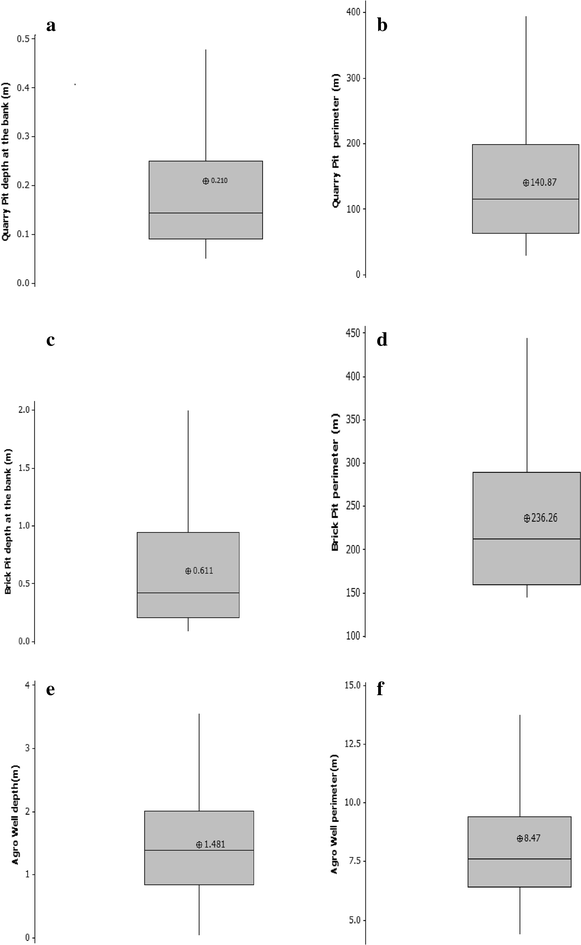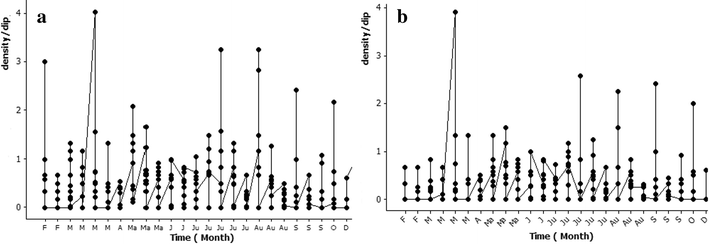Species composition and population dynamics of malaria vectors in three previously ignored aquatic systems in Sri Lanka
- PMID: 27165184
- PMCID: PMC4863324
- DOI: 10.1186/s12936-016-1316-4
Species composition and population dynamics of malaria vectors in three previously ignored aquatic systems in Sri Lanka
Abstract
Background: In 2015 alone there were an estimated 214 million new cases of malaria across the globe and 438,000 deaths were reported. Although indigenous malaria has not been reported in Sri Lanka since 2012, to date 247 imported cases of malaria have been identified. Knowledge of the locations, behaviour and vectorial capacity of potential malarial vectors is therefore needed to prevent future outbreaks. Attention is now being focused on some previously ignored habitats.
Methods: Active and abandoned granite and clay quarry pits, located in wet and intermediate zones, and agro wells located in the dry zone of Sri Lanka were mapped and sampled for 1 year, as potential mosquito breeding sites. Species composition and spatio-temporal variation in both malarial and other mosquito larvae were recorded.
Results: A total of 18 species of mosquito larvae were identified. Other than Anopheles culicifacies, the primary malaria vector, five species of potential malaria vectors (Anopheles vagus, Anopheles varuna, Anopheles nigerrimus, Anopheles peditaeniatus and Anopheles barbirostris) were found in all three aquatic systems. Additionally, Anopheles annularis was found in granite quarries and Anopheles subpictus and Anopheles pallidus in both types of quarry, but only during the initial sampling. Apart from potential malaria vectors, mosquito larvae such as Anopheles jamesii, Culex tritaeniorhynchus, Culex infula and Culex malayi were found in all three habitats at least once during the sampling period. Apart from potential malaria vectors and other mosquito larvae common to all three aquatic systems, Culex gelidus, Culex mimulus and Culex pseudo vishnui were detected in agro wells. Culex gelidus was also detected in granite quarry pits. Culex mimulus, Culex lutzia and Culex fuscocephala were detected in clay quarry pits. Accordingly, a total of 14, 13 and 15 mosquito species were identified in agro wells, granite and clay quarry pits, respectively.
Conclusions: Although zero occurrence of indigenous malaria has been achieved in Sri Lanka, the current study emphasizes the potential for future epidemics. The presence of native flora and fauna in abandoned granite and clay quarry pits and the need to extract drinking water from agro wells demand bio-sensitive control methods in these three aquatic systems.
Keywords: Agro well; Anopheline larvae; Clay quarry pit; Granite quarry pit; Malaria.
Figures





References
-
- WHO. World Malaria Report 2015. Geneva: World Health Organization; 2015. http://apps.who.int/iris/bitstream/10665/200018/1/9789241565158_eng.pdf?....
-
- Suwonkerd W, Ritthison W, Ngo CT, Tainchum K, Bangs MJ, Chareonviriyaphap T. Vector biology and malaria transmission in Southeast Asia in Anopheles mosquitoes—new insights into malaria vectors, Manguin S editor. 2013. http://cdn.intechopen.com/pdfs-wm/45385.pdf.
-
- Karunaweera ND, Galappaththy GNL, Wirth DF. On the road to eliminate malaria in Sri Lanka: lessons from history, challenges, gaps in knowledge and research needs. Malar J. 2014;13:59–68. http://www.malariajournal.com/content/13/1/59. - PMC - PubMed
-
- Konradsen F, Amerasinghe FP, van der Hoek W, Amerasinghe PH. Malaria in Sri Lanka. Current knowledge on transmission and control. Colombo: International Water Management Institute. 2000. https://core.ac.uk/download/files/153/6405335.pdf.
-
- Fernando SD, Dharmawardana P, Semege S, Epasinghe G, Senanayake N, Rodrigo C, et al. The risk of imported malaria in security forces personnel returning from overseas missions in the context of prevention of re-introduction of malaria to Sri Lanka. Malar J. 2016;15:144. http://malariajournal.biomedcentral.com/articles/10.1186/s12936-016-1204-y. - DOI - PMC - PubMed
Publication types
MeSH terms
Grants and funding
LinkOut - more resources
Full Text Sources
Other Literature Sources

